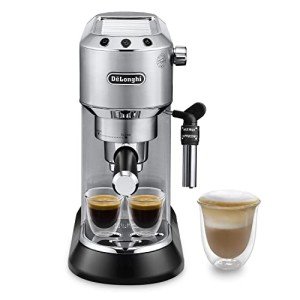The Ultimate Guide to Cappuccino Machines: Brewing the Perfect Cup
Cappuccinos are a cherished coffee drink that combines the abundant tastes of espresso with steamed milk and milk foam. For numerous, absolutely nothing tastes much better than a homemade cappuccino crafted with accuracy. Nevertheless, reproducing the skill of a barista in your home requires the ideal devices. This is where cappuccino machines enter play. Italian Espresso Machines explores the different types of cappuccino machines, how they work, and tips for selecting the best one for your requirements.
What is a Cappuccino Machine?
A cappuccino machine is a customized developing gadget developed to make coffees and other espresso-based drinks. These machines typically include a built-in espresso maker, a milk frother, and various controls for changing temperature and pressure. Cappuccino machines can be manual, semi-automatic, or totally automatic, offering numerous levels of user control depending upon the intricacy of the machine.
Types of Cappuccino Machines
1. Manual Espresso Machines
- Description: These machines need users to operate most functions manually, including grinding coffee beans, tamping the premises, pulling the espresso shot, and frothing the milk.
- Pros:
- Offers total control over the developing procedure.
- Can produce high-quality, café-like espresso.
- Cons:
- Steeper knowing curve.
- Requires more effort and time.
2. Semi-Automatic Espresso Machines
- Description: Semi-automatic machines automate some processes, such as water pressure. Users still require to grind coffee and froth milk by hand.
- Pros:
- Balanced control and benefit.
- Enables room for experimentation.
- Cons:
- Still requires useful abilities.
- Can be complex for novices.
3. Totally Automatic Espresso Machines
- Description: These machines automate the whole developing process, from grinding to frothing. Users merely select the wanted drink.
- Pros:
- Extremely convenient and simple to use.
- Constant results with little effort.
- Cons:
- More costly.
- Restricted control over the brewing process.
4. Super Automatic Espresso Machines
- Description: Similar to completely automatic machines, however these models consist of features like a built-in milk frother and grinder. They prepare drinks with simply the touch of a button.
- Pros:
- Ultimate benefit; makes numerous beverages quickly.
- Built-in cleaning and upkeep functions.
- Cons:
- High preliminary expense.
- Less hands-on experience with coffee making.
Secret Features to Consider
When selecting a cappuccino machine, a number of features can considerably influence efficiency and user experience. Here are some vital elements to evaluate:
1. Construct Quality
- Materials used (stainless steel, plastic)
- Durability and longevity
2. Capability
- Water reservoir size
- Bean hopper capacity
3. Frothing Capability
- Type of frothing wand (manual, automatic)
- Steam pressure and temperature control
4. Reduce of Use
- Intuitive controls
- Cleaning and maintenance requirements
5. Cost
- Range from budget to high-end designs
- Think about guarantees and customer assistance choices
6. Brand Reputation
- User reviews and expert opinions
- Availability of replacement parts
The Brewing Process
To brew the best cappuccino at home, follow this process, despite the machine type:
- Prepare the Espresso: Use newly ground coffee beans and pull a double shot (approximately 2 ounces) of espresso.
- Froth the Milk: Steam fresh milk to a temperature about 150 ° F( 65 ° C)using the steam wand or automatic frother.
- Integrate: Pour the steamed milk over the espresso, followed by a layer of milk foam (equivalent parts espresso and steamed milk, with about 1 cm of foam).
For a graph, here's a simple table comparing the characteristics of the cappuccino machine types:
| Machine Type | Control Level | Ease of Use | Cost Range | Perfect For |
|---|---|---|---|---|
| Manual Espresso Machine | High | Difficult | Low to Medium | Coffee lovers, perfectionists |
| Semi-Automatic Machine | Medium | Moderate | Medium | Home baristas, hobbyists |
| Completely Automatic Machine | Low | Easy | Medium to High | Casual drinkers |
| Super Automatic Machine | Extremely Low | Extremely Easy | High | Hectic experts |
Often Asked Questions (FAQs)
What is the best milk to use for cappuccinos?
Whole milk is typically chosen for frothing due to its fat material, which develops a creamy texture. However, options like almond milk, oat milk, or soy milk can be utilized, though they might require different frothing techniques.
How do I clean my cappuccino machine?
Most machines feature specific cleaning directions. Generally, you need to routinely clean up the group head, steam wand, and drip tray. For automatic machines, lots of designs include self-cleaning cycles.
Can I use pre-ground coffee instead of whole beans?
Yes, you can use pre-ground coffee. Nevertheless, freshly ground coffee usually produces a more delicious espresso due to the oils in the beans being preserved.
How much should I invest in a cappuccino machine?
The rate differs significantly based upon features, brand name, and quality. A fundamental, excellent quality machine may begin around ₤ 200, while high-end super automatic machines can exceed ₤ 2,000.
How often should I replace my cappuccino machine?
With correct maintenance, a high-quality cappuccino machine can last for numerous years. Nevertheless, you might consider upgrading if you discover your machine no longer fulfills your brewing needs or experiences performance issues.
Cappuccino machines are powerful allies in delivering the perfect brew in the house. Whether you prefer manual interaction with your coffee or choose the convenience of totally automated machines, comprehending the numerous types and their functions will assist you in making the right option. By investing in the perfect machine for your requirements and using the right methods, anyone can take pleasure in a barista-quality cappuccino from the convenience of their own kitchen. With a little persistence and creativity, the art of cappuccino developing can become a wonderful ritual, developing not just coffee however moments of delight.

